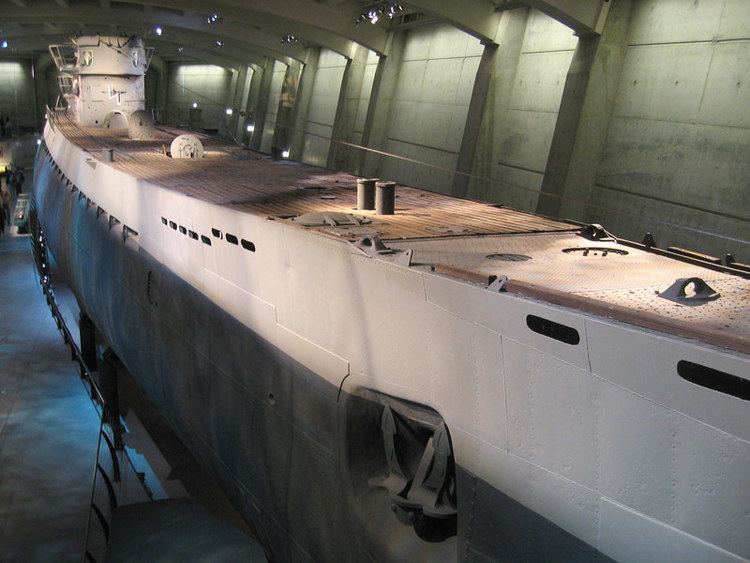Name U-516 Laid down 12 May 1941 Launched 16 December 1941 Draft 4.7 m Builder Deutsche Werft | Ordered 14 February 1940 Commissioned 21 February 1942 Construction started 12 May 1941 Length 77 m Beam 6.76 m | |
 | ||
Fate Surrendered, May 1945 at Loch Eriboll in Scotland; transferred to Lisahally in Northern Ireland. Sunk, January 1946 Part of | ||
German submarine U-516 was a Type IXC U-boat of Nazi Germany's Kriegsmarine during World War II.
Contents
She was laid down at the Deutsche Werft (yard) in Hamburg as yard number 312 on 12 May 1941, launched on 16 December 1941 and commissioned on 21 February 1942 with Korvettenkapitän Gerhard Wiebe in command.
U-516 began her service career with training as part of the 4th U-boat Flotilla from 10 March 1941. She was re-assigned to the 10th flotilla for operations on 1 September 1942, then the 33rd flotilla on 1 October 1944.
She carried out six patrols, sank 16 ships and damaged one more. She surrendered in May 1945 at Loch Eriboll in Scotland and was transferred to Lisahally in Northern Ireland for Operation Deadlight. She was sunk in January 1946.
Design
German Type IXC submarines were slightly larger than the original Type IXBs. U-516 had a displacement of 1,120 tonnes (1,100 long tons) when at the surface and 1,232 tonnes (1,213 long tons) while submerged. The U-boat had a total length of 76.76 m (251 ft 10 in), a pressure hull length of 58.75 m (192 ft 9 in), a beam of 6.76 m (22 ft 2 in), a height of 9.60 m (31 ft 6 in), and a draught of 4.70 m (15 ft 5 in). The submarine was powered by two MAN M 9 V 40/46 supercharged four-stroke, nine-cylinder diesel engines producing a total of 4,400 metric horsepower (3,240 kW; 4,340 shp) for use while surfaced, two Siemens-Schuckert 2 GU 345/34 double-acting electric motors producing a total of 1,000 shaft horsepower (1,010 PS; 750 kW) for use while submerged. She had two shafts and two 1.92 m (6 ft) propellers. The boat was capable of operating at depths of up to 230 metres (750 ft).
The submarine had a maximum surface speed of 18.3 knots (33.9 km/h; 21.1 mph) and a maximum submerged speed of 7.3 knots (13.5 km/h; 8.4 mph). When submerged, the boat could operate for 63 nautical miles (117 km; 72 mi) at 4 knots (7.4 km/h; 4.6 mph); when surfaced, she could travel 13,450 nautical miles (24,910 km; 15,480 mi) at 10 knots (19 km/h; 12 mph). U-516 was fitted with six 53.3 cm (21 in) torpedo tubes (four fitted at the bow and two at the stern), 22 torpedoes, one 10.5 cm (4.13 in) SK C/32 naval gun, 180 rounds, and a 3.7 cm (1.5 in) as well as a 2 cm (0.79 in) anti-aircraft gun. The boat had a complement of forty-eight.
1st patrol
U-516'es first patrol was preceded by a short trip from Kiel in Germany to Kristiansand in Norway. The patrol itself began with the boat's departure from Kristiansand on 15 August 1942. She passed through the 'gap' separating Iceland and the Faroe Islands before heading out into the Atlantic Ocean.
She damaged the Port Jackson with 14 rounds from her deck gun 480 nautical miles (890 km; 550 mi) west of Cape Clear, (at the southern tip of Ireland), on the 27th, after a spread of four torpedoes had missed. A small fire was started on the ship, but her accurate return fire discouraged the U-boat which broke off the attack. Port Jackson escaped at top speed into haze.
The boat moved to the waters off northern South America where her success rate shot-up, although one target required seven torpedoes to sink her.
She entered Lorient, on the French Atlantic coast, on 14 November.
2nd and 3rd patrols
For her second foray, U-516 headed toward South Africa. She sank three ships in the vicinity of East London and a fourth off the coast of southern Namibia.
Her third sortie was also in a southerly direction; its furthest point was reached between South America and the Cape Verde Islands.
4th patrol
Patrol number four took the boat to the Caribbean Sea. One of her victims was the Colombian sailing ship Ruby, which was sunk with the deck gun on 18 November 1943.
Another was the Elizabeth Kellog. This ship, which had been torpedoed and abandoned on the 23rd, ran around the survivors (she was still underway because the engines could not be secured). Her after magazine exploded and she burned for 12 hours before sinking.
The U-boat was damaged by an unidentified aircraft on 19 December 1943.
5th patrol
The boat's fifth patrol saw her sink the Esso Harrisburg 200 nautical miles (370 km; 230 mi) northwest of Aruba in the Caribbean. She then made her way to Flensburg via the Denmark Strait that separates Greenland and Iceland. She docked at the German harbour on 4 October 1944.
6th patrol and fate
Having moved from Kiel to Horten Naval Base, (south of Oslo) and then Kristiansand, she left the Norwegian port on 5 April 1945. She surrendered at Loch Eriboll on 14 May and was then transferred to Lisahally in Northern Ireland for Operation Deadlight. She was sunk on 2 January 1946 at 56°06′N 09°00′W.
